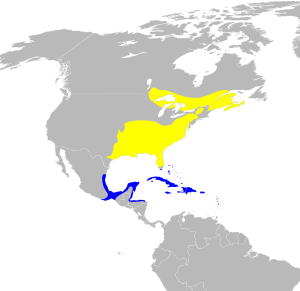Northern parula facts for kids
The northern parula (Setophaga americana) is a small, colorful bird. It's a type of New World warbler. These birds live in eastern North America, from southern Canada all the way down to Florida.
Quick facts for kids Northern parula |
|
|---|---|
 |
|
| Conservation status | |
| Scientific classification | |
 |
|
| Range of S. americana Breeding range Wintering range | |
| Synonyms | |
|
Contents
What Does a Northern Parula Look Like?
The northern parula is one of the smallest migratory warblers in North America. It is about 11 to 12 centimeters (4 to 5 inches) long. Its wingspan is about 16 to 18 centimeters (6 to 7 inches). This tiny bird weighs only 5 to 11 grams (less than half an ounce).
Colors and Markings
Northern parulas have mostly blue-gray feathers on their upper body. They have a greenish patch on their back. You can also see two white bars on their wings. Their chest is yellowish, fading to white on their belly.
Male and Female Differences
During summer, male northern parulas have bluish and reddish bands across their chest. They also have clear white marks around their eyes. Females look similar but are usually duller in color. They often do not have the chest bands that males have. After the breeding season, both males and females get duller feathers.
Sounds and Songs
The northern parula's song sounds like a click-like trill or buzz. It often sounds like zeeeeee-yip. Their call is a soft chip sound.
Where Do Northern Parulas Live?
Northern parulas are migratory birds. This means they travel long distances between seasons. They spend their winters in southern Florida, northern Central America, and the West Indies. Sometimes, a few birds might even fly far off course to western Europe.
Changes in Their Home Range
Even though these birds are still common, they have disappeared from some areas. They used to breed in parts of the Midwest. They also lived in many areas in Massachusetts, New Jersey, Connecticut, New York, Rhode Island, and Vermont.
Scientists think several things might have caused this. Changes in their habitat could be one reason. Also, air pollution might have harmed the special plants they use for nesting. Cutting down forests and draining wet areas have also reduced their homes.
What Kind of Places Do Northern Parulas Like?
Northern parulas live in different places depending on the season. They mostly live in forests. However, birds from northern and southern areas choose different types of forests for breeding.
Northern and Southern Habitats
In the north, they prefer mature, moist forests with evergreen trees. They like places with hanging moss or twigs. These are often found in wet spruce bogs or hemlock swamps. In the south, they breed in mature, moist forests near rivers. These areas often have a lot of Spanish moss.
Winter Homes
When it's not breeding season, northern parulas are less picky about where they live. During migration and winter, they can be found in many different places. This includes pastures, various types of forests, and even farms.
Northern Parula Life Cycle and Reproduction
Northern parulas usually have one mate, but sometimes a male might have more than one. In warmer southern areas, they can start breeding as early as March. In the north, they don't start nesting until May.
Nesting Habits
They build their nests in humid woodlands. They especially like places with hanging lichen called Old Man's Beard or Spanish moss. The female bird hollows out a clump of this hanging plant material. She then lines the nest with plant fibers, animal hair, grass, or pine needles. These nests are usually about 7 centimeters (3 inches) wide.
They often build their nests near water. Many nests are found at the end of branches hanging over water. Southern parulas often raise two groups of babies each year. Northern parulas usually only raise one group.
Eggs and Young Birds
The female lays 3 to 7 eggs in the nest. The eggs hatch after about 12 to 14 days. The young birds leave the nest when they are about 10 to 11 days old. They are ready to have their own babies the next year.
What Do Northern Parulas Eat?
Northern parulas mostly eat small invertebrates. These are creatures without backbones. Their diet includes spiders, damselflies, locusts, bugs, grasshoppers, aphids, beetles, caterpillars, flies, wasps, and ants.
Favorite Foods
Caterpillars and spiders are their most common foods. In winter, they eat more beetles. They might also eat berries, seeds, and nectar sometimes.
How They Find Food
These birds are clever hunters. They often hover near plants to pick off prey. They can also fly from a branch to catch insects in the air. Sometimes, they even hang upside down to get food! They usually look for food in the middle or upper parts of trees. Occasionally, they will search for food on the ground too.
Images for kids
-
A northern parula in Galveston, Texas during spring migration.
-
A northern parula in High Island, Texas.
See also
 In Spanish: Chipe azul olivo norteño para niños
In Spanish: Chipe azul olivo norteño para niños




